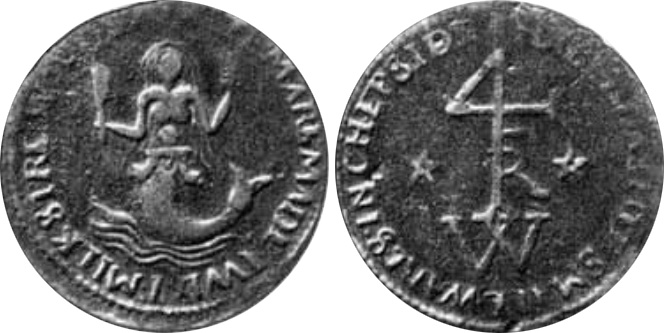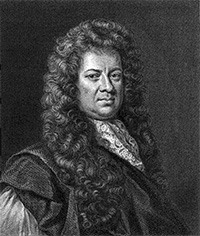A Taste of English Tavern Tokens
By George Manz | Thursday, 1 August 2002
In the 17th century, Britons' love of drink made tokens issued by taverns and inns a popular commodity. Today, the pieces allow us to savor a flavorful era.
I admit it. I like beer. I've also been known to drink wine from time to time. I suspect many of you have a certain fondness for these beverages, too. However, even though I've been a coin collector for 40 years, I only recently discovered that these popular libations were celebrated on advertising tokens issued by 17th-century English inns, taverns and alehouses.
British Beverage Basics
Ale, beer and wine have been consumed in Britain for quite some time, according to George Berry, author of Seventeenth Century England: Traders and Their Tokens and the wonderful book Taverns and Tokens of Pepys' London. The commonest drink in Roman Britain was ale, he notes. It was so popular that a law passed during King Edgar's reign (A.D. 957-75) restricted the number of alehouses to one per village. Many church and social festivities witnessed brewing on a large scale producing church ales, midsummer ales, lamb ales, bride ales and tithe ales, to celebrate the appropriate occasion, Berry adds.
Britain became acquainted with French wine following the Norman Conquest in 1066; Dutch beer made with hops appeared in Britain in the early 15th century. Berry explains:
Throughout the Middle Ages wine and ale were both consumed, the former by the aristocracy and merchants, the latter by country peasants and poorer townsfolk. Each alehouse and inn brewed its own ale.
Originally, alehouses and taverns were regarded as one and the same, but Berry mentions that author Michael Brander...
...suggests that the former provided ale and entertainment, and the latter food and wine in addition.
During the reign of Tudors, trade increased significantly, as did the number of drinking establishments. Berry quotes a 1557 census, which tallied 14,202 alehouses, 1,631 inns and 329 taverns.
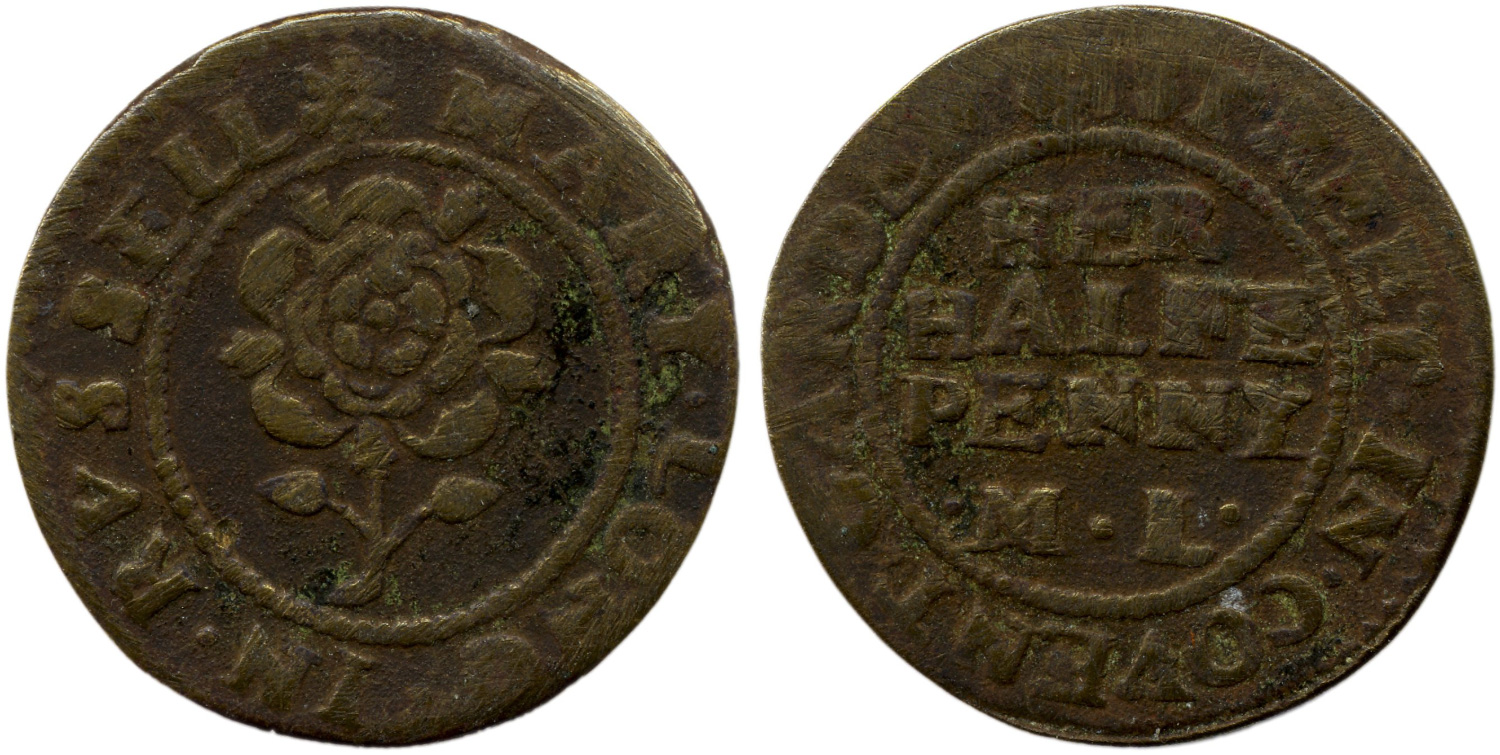
This halfpenny token was issued by Mary Long, proprietor of the Rose Tavern on Russell Street in Covent Garden. She also issued pieces with a farthing value.
However, the English Civil War (1642-46) and subsequent rule of the Commonwealth (164-60), led by Olivier Cromwell, put a damper on most forms of merrymaking. During the height of Cromwell's Protectorate (1653-58), radical Protestantism and severe social legislation set the standards for public morality. Church attendance was mandatory, and plays, gambling and horse racing were prohibited. Many alehouses closed. Berry quotes from a government order dates 1656 to the Justices of Hertfordshire instructing them to...
...take special care for the suppressing of all such alehouse keepers as are or shall be convicted of the profanation of the Lord's Day by receiving into their houses any company or of swearing, drunkenness... gaming or playing at Tables, Billiard Table, Shovel Board, Cards, Dice, Ninepins or of keeping a Bowling Alley or any of them or any other games.
In his book A Descriptive Catalogue of the London Traders, Tavern, and Coffee-House Tokens Current in the Seventeenth Century, Jacob Henry Burn quotes from other Commonwealth government ordinance dated 1656:
If any person or persons, commonly called fiddlers, or minstrells, shall at any time be taken playing, fiddling, or making musick, in any inn, alehouse or tavern, or shall be taken proffering themselves, or desiring or entreating any person or persons to hear them play or make musick in the places aforesaid, every such person or persons so taken shall be adjudged, and are hereby adjudged and declared, to be rogues, vagabonds, and sturdy beggars.
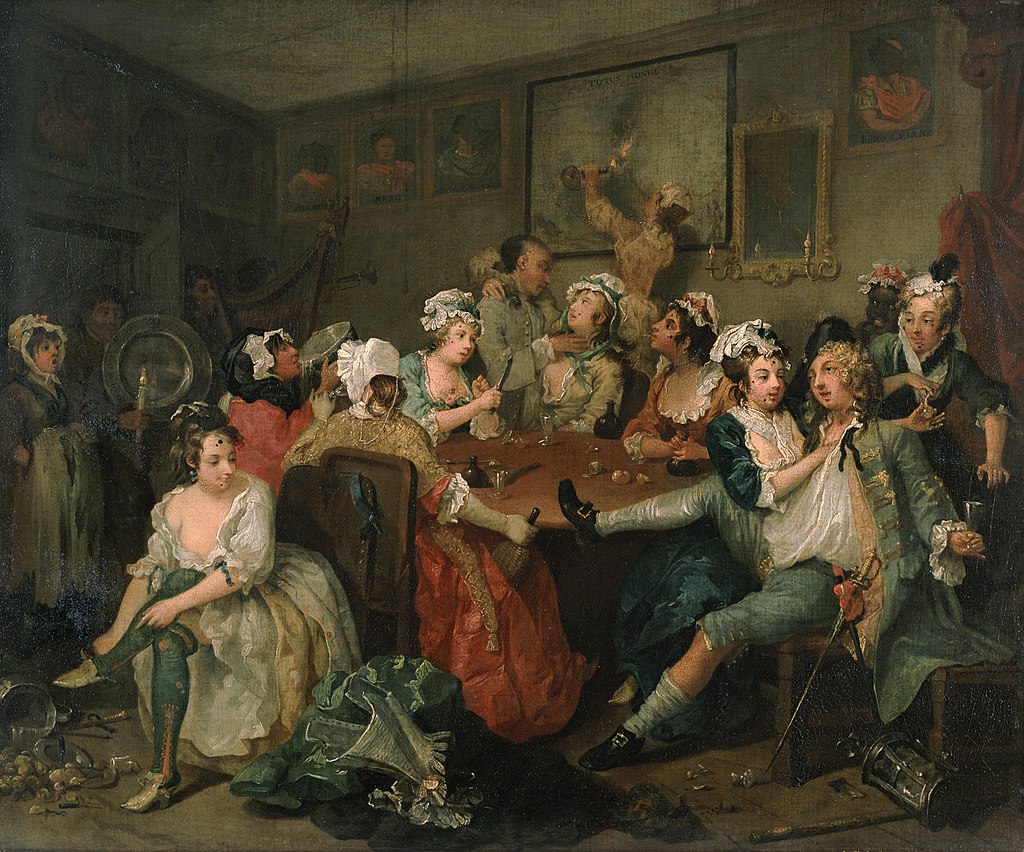
After the termination of Commonwealth rule, taverns and inns often were rather rowdy. William Hogarth's A Rake's Progress III: The Rake at the Rose-Tavern aptly captures the mood of the times.
Needless to say, such didactic governmental control of personal liberty was not popular with the English people. With the death of Cromwell, the rule of the Commonwealth/Protectorate crumbled. Resentment of the military and its guiding force of Puritanism abounded, and Britain was ready for the rowdy revelry of Charles II and the Restoration.
Token Information
The primary reason alehouses, inns and taverns struck tokens was that small change (such as farthings and halfpence) was in short supply. Many merchants were forced to coin their own tokens in order to make change for their customers, according to Richard G. Doty, curator of numismatics for the Smithsonian Institution in Washington, D.C., and member of the Conder Token Collector's Club. In his article British Tokens and the Industrial Revolution, published as a special supplement to the April 29, 1987, issue of Coin World, Doty describes an assortment of issues produced by English shopkeepers and craftsmen between 1648 and 1674. Although most of the specimens were round, he notes they also came in other shapes, such as hearts, squares, lozenges, event octagons.
In Berry's Seventeenth Century England: Traders and Their Tokens, the author reports additional details:
About a hundred or so octagonal pieces were struck, eighty heart-shaped tokens, twenty square and mere handful of diamond-shaped pieces... [The specimens] normally carry the name of the issuer, the town or village where his trade is practiced, the arms or symbol of his trade, and the initials of the issuer and his wife. More than half are dated and frequently the value is given, especially if it is a halfpenny or a penny.
Early English Inns
Recent research indicates that during the 17th century, Doty says...
...innkeepers were responsible for more tokens than members of any other profession - well over 1,000 varieties.
These pieces not only are of numismatic interest, but also can lead a collector to some fascinating, historical tales.
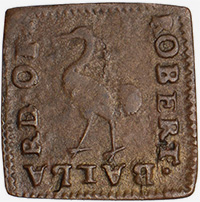
This rare, square half-penny token advertised Robert Ballard's Ostrich Inn in Kingston (Surrey).
For example, Samuel Mills, proprietor of the Ostrich Inn, issued one of the more interesting tokens in 1957. The obverse bears his name and a stylized rendering of an ostrich. The inn was located in Colnbrook, but spelling wasn't standardized at the time. That's why the reverse of the Mills token reads IN COOLBROOKE - 57 /S.M.M. The 57 on the reverse represents the year 1657 while letters S.M.M. are the combiner initials of Samuel Mills and his wife, Margaret.
The Ostrich, which still stands today, has a long history as an inn, beginning in the 1400s. Berry writes that in the establishment's earlier days, a landlord named Jarman took a sadistic delight in murdering his guests in quick succession. They were tipped out of their beds through a trap door into a bubbling cauldron to be burned alive before drowning.
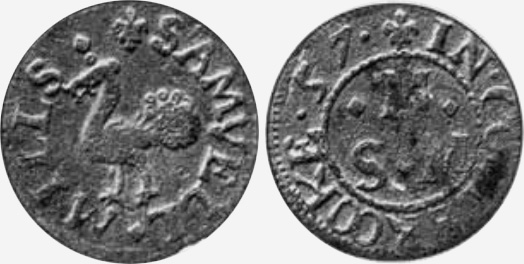
Samuel Mills issued this token for another Ostrich Inn located in Colnbrook in 1657.
Not all inns in this town were owned by men. Alice Goad, a widow, issued a halfpenny token in 1669. The obverse reads ALCE COAD AT THE BELL, while the reverse reads IN COLBROOKE 1669 HER HALF PENY.
Another historical establishment, the Reindeer Inn, is featured on an undated token issued by proprietor Edward Aynsworth and his wife, Elizabeth. The obverse shows the antlered beast and reads YE RAINEDEARE IN, while the reverse indicates the location in BISHOP STARTFORD and the couple's initials E.E.A..
It seems that Elizabeth Aynsworth had a somewhat shady past. Berry notes that Elizabeth...
...had been banished from Cambridge for running a brothel. When the vice chancellor and numerous college dignitaries unwittingly stopped at the Reindeer one night on their way to London, they were royally entertained and fed off silver plate. In the morning, she refused to accept any payment, claiming that by expelling her from Cambridge they had made her fortune.
The Red Lion, an inn owned by Richard Lucas, also issued a farthing token in 1652. In his book British Trade Tokens: A Social and Economic History, J.R.S. Whiting describes the fate of Oliver Cromwell: When the Lord Protector of England died in 1658, his body was buried at Westminster Abbey until Charles II was restored to the throne. The new king ordered Cromwell's exhumation in 1661; his body was taken to the Red Lion Inn and later transported to the gallows called Tyburn Tree. On the anniversary of Charles I's execution, the bodies of Cromwell and two of his supporters were hung there until night, then their heads were cut off.
Lines on the Mermaid Tavern
Souls of Poets dead and gone, What Elysium have ye known, Happy field or mossy cavern, Choicer than the Mermaid Tavern? Have ye tippled drink more fine Than mine host's Canary wine? Or are fruits of Paradise Sweeter than those tainty pies Of venison? O generous food! Drest as though bold Robin Hood Would, with his maid Marian, Sup and bowse from horn and can.
I have heard that on a day Mine host's sign-board flew away, Nobody knew whiter, till An astrologer's odd quill To a sheepskin gave the story, Said he saw you in your glory, Underneath a new old sign Slipping beverage divine, And pledging with contented smack The Mermaid in the Zodiac.
Souls of Poets dead and gone, What Elysium have ye known, Happy field or mossy cavern, Choicer than the Mermaid Tavern?
John Keats
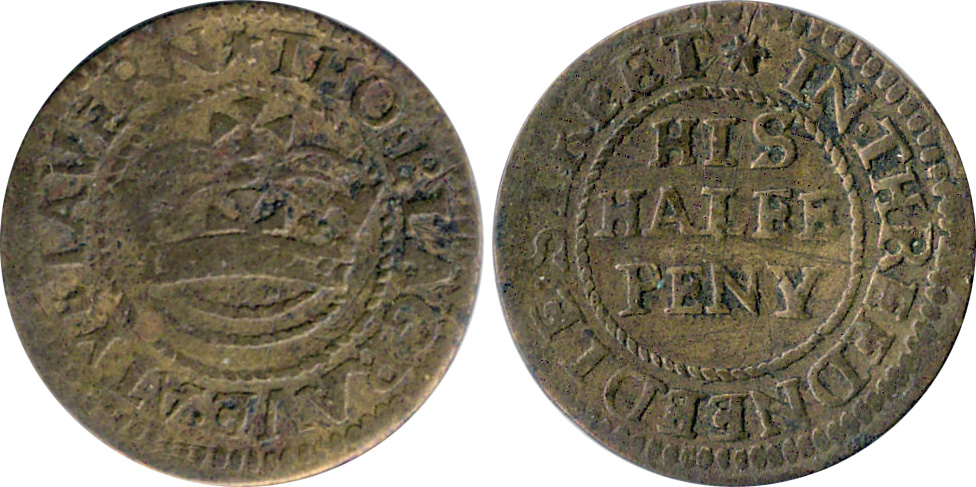
Thomas Blagrave, proprietor of the popular Crown tavern (located on Threadneedle Street near the Royal Exchange), issued this undated halfpenny token.
London Taverns and Alehouses
Taverns functioned as a stage for much of the social interaction in Restoration London. The flavor of the times was captured by tavern and alehouse aficionado Samuel Pepys (pronounced Peeps), a naval clerk who kept a diary from 1660 to 1669. Pepys delighted in eating out as often as he could, coupled with a drink or two, and he meticulously documented his excursions. Although Pepys does not mention advertising tokens in his daily log, Berry's Taverns and Tokens of Pepys' London states that almost 1,000 tavern pieces were issued during this period in London alone and provides details about specimens from 80 taverns that Pepys frequented.
Berry notes that the first legislation...
...to control the setting up and supervision of taverns as distinct from inns was enacted during the reign of Edward VI in 1553. The Act required that all taverns be licensed, that the number of London taverns be restricted to forty and that all forms of amusement in conjunction with drinking be barred.
But by 1613, Berry estimates there were more than 1,000 alehouses in London, many of them illegal.
The Black Death
The Great Plague of 1665 forced many taverns and alehouses to close down to help stop the spread of illness. It was not understood how the Black Death (bubonic plague) was transmitted; isolation of victims seemed the only way to slow the devastation. In the beginning, people who became ill were locked in their homes with their families for 40 days after the patient had either recovered or died. Guards were posted to keep people from escaping.
In June, Pepys wrote:
This day, much against my Will, I did in Drury lane see two or three houses marked with a red cross upon the doors and Lord have mercy upon us write there - which was a sad sight to me, being first of that kind that to my remembrance I ever saw.
But Lord, how empty the streets are, and melancholy, so many poor sick people...and so many sad stories overheard as I walk, everybody talking of this dead, and that man sick, and so many in this place, ans so many in that. And they tell me in Westminster there is never a physician, but one apothecary left, all being dead.
So many died so quickly that bodies literally began to stack up; graves could not be dug fast enough. Although 70,000 people officially were listed as perishing from the Black Death, it is estimated that 100,000 people died of the disease, including several tavern keepers and alehouse proprietors who had issued tokens. Among them was Morgan Cowarne, who had issued both a farthing and a halfpenny for the Rose and Crown at Tower Stairs.
A Cofounding Conflagration
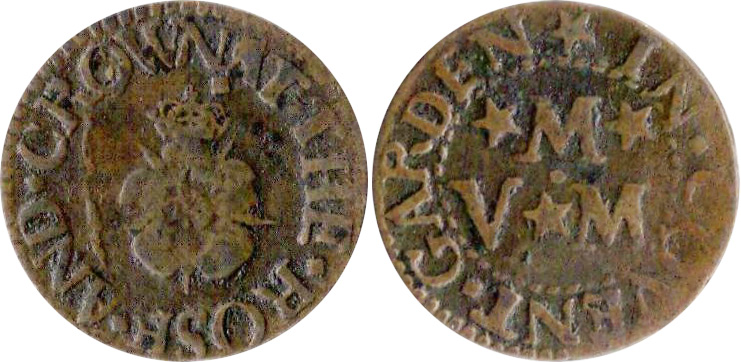
Token issued by the Rose and Crown, destroyed in the Great Fire of London in September 1666.
The Great Fire of London ended the plague. The inferno began on September 2, 1666, and destroyed about 80 percent of the city, including St. Paul's Cathedral, 87 churches and approximately 13,200 homes. Quite simply, it razed medieval London. Many of the taverns and alehouses that issued tokens were destroyed, including the Dolphon, Sun, King's Head, Angel, and Rose and Crown. Surprisingly, only a small number of Londoners were killed in the fire, but the flames exterminated so many rats that the spread of disease was halted.
Among the few taverns that survived the holocaust was the Bear at Bridge Foot in Southwark, on the other side of the Thams River. (The Bear was in business for at least 450 years, from the early 14th century to 1761.) Two different owners - Cornelius Cooke and Abraham Browne - issued tokens. The Cooke specimen is a farthing that displays the owner's name and a bear with a chain on the obverse; the Browne token is a halfpenny also with his name encirculing a bear and chain. Both pieces are undated.
In his book, Berry includes several stories about the Bear. One is Pepys' diary entry about the Duke of Richmond's elopement with a certain Mrs. Stewart. Apparently, because Charles II was extremely displeased with the proposed marriage, the Duke ordered a coach to the Bear, where they stole away into Kent without the King's leave. Berry calls Mrs. Stewart...
...the society beauty who is reputed to have modeled for the Britannia reverse on the contemporary coinage.
Samuel Pepys' Perspective: London Ablaze
Samuel Pepys Rose from humble beginnings to become a successful bureaucrat in Restoration London. As his career prospered, he recorded the daily events of his life in a diary, begun on New Year's Day, 1660, when he was 27 years old. In a curious shorthand, he compiled chatty, detailed reports on the politics, scandals, events and gossip of an exciting transitional era.
At the time he wrote about the Great Fire of London in September 1666, Pepys held the prestigious post of Clerk of the Actfs of the Navy Board. From his residence on Seeting Lane, near the Tower of London, he saw the flames after being awakened by a servant. Pepys decided to investigate and report his findings:
So down, with my heart full of trouble, to the Lieutenant of the Tower, who tells me that it began this morning in the King's baker's house in Pudding Lane, and that it hath burned St. Magnus's Church and most part of Fish Street already. So I rode down to the waterside,... and there saw a lamentable fire... Everybody endeavouring to remove their goods, and flinging into the river or bringing them into lighters that lay off; poor people staying in their houses as long as till the very fire touched them, and then running into boats, or clambering from one pair of stairs by the waterside to another. And among other things, the poor pigeons, I perceive, were loth to leave their houses, but hovered about the windows and balconies, till they some of them burned their wings and fell down.
Having stayed, and in an hour's time seen the fire rage every way, and nobody to my sight endeavouring to quench it... I to Whitehall (with a gentleman with me, who desired to go off from the Tower to see the fire in my boat); and there up to the King's closet in the Chapel, where people came about me, and I did give them an account [that] dismayed them all, and the word was carried into the King, so I was called for, and did tell the King and Duke of York what I saw; and that unless His Majesty did command houses to be pulled down, nothing could stop the fire. They seemed much troubled, and the King commanded me to go to my Lord Mayor from him, and command him to spare no houses...
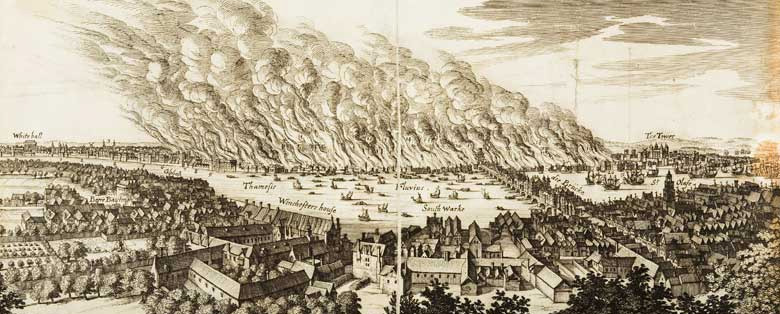
A Lasting Legacy
Taverns were not just places to meet friends and grab a meal and some ale or wine. These establishments often offered entertainment as well. For example, the Mermaid Tavern, located in Cheapside near St. Paul's Cathedral, hosted the Friday Street Club (also known as the Mermaid Club), a literary society begun in 1603 by Sir Walter Raleigh and attended by such writers as Ben Jonson and William Shakespeare.
Freed from social shackles of the Commonwealth period, some establishments presented theatrical or musical entertainment. In 1661 and 1662, Pepys reported visiting the Red Bull in St. John Street, where attempts were being made to produce plays for public performance. On another occasion, Pepys was delighted to find fiddling at the Dolphin in Tower Street. Apparently the fiddling was so good, Pepys wrote that he danced for...
...the first time that ever I did in my life, which I did wonder to see myself do.
Since I don't dance, I raise my frosted mug of homemade beer to all those inns, taverns and alehouses of 17th century England that issued tokens. Cheers! On with the revelry!
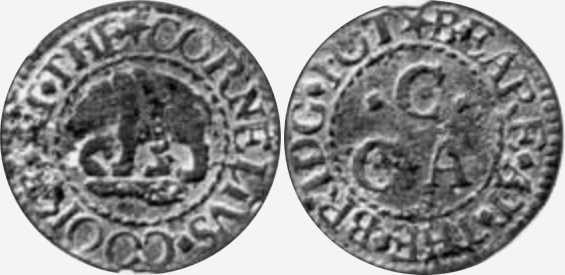
The Bear at the Bridge Foot in Southwark survived London's Great Fire of 1666.
Acknowledgments
I would like to thank Jane L. Colvard, ANA research librarian, and Harold Welch, editor and librarian for the Conder TOken Collector's Club, for supplying books, articles and other research material. Also Kirstin Munro at The British Museum was extremely helpful in providing illustrations for this article.
Sources
- Berry, George, Discovering Trade Tokens. Tring, UK: Shire Publications, 1969.
- Berry, George, Seventeenth Century England: Traders and Their Tokens. London: Seaby Publications Limited, 1988.
- Berry, George, Taverns and Tokens of Pepys' London. London: Seaby Publications Limited, 1978.
- Burn, Jacob Henry. A Descriptive Catalogue of the London Traders, Tavern, and Coffee-House Tokens Current in the Seventeenth Century: Presented to the Corporation Library by Henry Benjamin Hanbury Beaufoy. London: Corporation of The City of London, 1855.
- Doty, Richard G. British Tokens and the Industrial Revolution. Special supplement to Coin World (April 1987).
- Wetton, J.L. Seventeenth Century Tradesmen's Tokens. Newcastle: Crobitt & Hunter, Ltd., 1969.
- Whiting, J.R.S. British Trade Tokens: A Social and Economic History. New York: Drake Publishers Inc. 1972.
- Williamson, George C. Trade Tokens Issued in the Seventeenth Century in England, Wales, and Ireland, by Corporations, Merchants, Tradesmen, etc. A New and Revised Edition of William Boyne's Work. Vols I and II. New Yorl: Burt Franklin, 1970.

